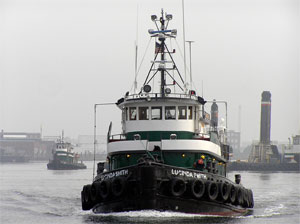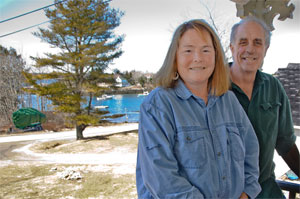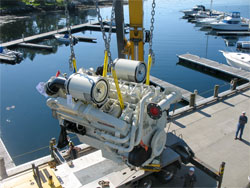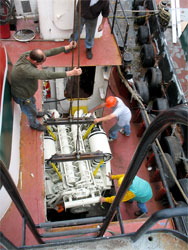Jon and Cindy Smith live and work from their home on a hill overlooking a small cove dotted with Maine lobster boats. Situated on Southport Island, a few miles south of Boothbay Harbor, the setting is an idyllic one, relatively free of the dense, emissions-rich air associated with larger ports.
 |
|
The 85-foot, 2,800-hp Lucinda Smith is the flagship of the company's fleet of three tugs and a crew boat. Lucinda Smith has been repowered with two Cummins QSK 38 Tier 2 main engines. (Courtesy Interport Towing & Transportation) |
The Smiths own Interport Towing & Transportation Inc., a company consisting of three older tugboats and a crewboat. All four vessels have some level of Tier 2 emissions-compliant machinery, either for propulsion or for electricity.
The couple decided to repower their flagship tug, the 85-foot Lucinda Smith, when the 16-149 Detroit Diesels seemed to protest every time they had to work.
"They were dinosaurs," said Jon. "It was getting to be too expensive to keep them running due to the scarcity and cost of parts, not to mention the down time and loss of revenue. It seems they'd only break down when they were working on a job. I loved those engines. They are so simple to work on, but we were losing money with the down time."
The Smiths went shopping for engines at the International WorkBoat Show in New Orleans, initially looking for rebuilt Tier 1 engines, but finally deciding on new Tier 2 Cummins QSK 38 diesels rated at 1,400 hp each at 1,800 rpm.
"It was a great education with all the engine manufacturers together," said Jon. "It became apparent that by the time we were finished with the installation, the cost between new Tier 2 engines and rebuilts became less of an issue."
 |
|
Jon and Cindy Smith, the owners of Interport Towing & Transportation, both have 200-ton licenses. (Brian Gauvin photo) |
The engines were installed in 2008, and the Smiths are happy with the result of their choice.
"The Lucinda's new engines are a total of 2,800 horsepower, but with the Kort nozzles, which can add up to 30 percent more horsepower, we call her 3,600 horsepower," Jon said.
This wasn't their first foray into the new world of emissions-compliant engines. In 2006, the Smiths installed two Tier 1 Cummins KTA 19 mains in their 67-foot Camerons Point, which also boasts a Tier 2 Northern Lights 32-kW generator.
The 67-foot Eddie R, their third tug, is powered by two Lugger 6170 mains, but the Smiths installed two new Tier 2 Northern Lights generators in December 2010. And the company's 48-foot crew boat Daisy W has Tier 2 Cummins QSL 9 mains.
To emit or not to emit. "It made sense, given the cost of doing a major repower," said Jon. "But it's also a benefit to our customers having a tug with such low emissions on the job site. And it's the right thing to do."
The Interport fleet is currently working on a three-year job, tending barges on the Sakonnet River bridge project that, when completed, will span the river between Tiverton and Portsmouth, R.I. "The Eddie R and the Camerons Point are tending barges," said Jon. "All three are model-bow boats. The Lucinda is big enough to be the line-haul boat and take the barges out to sea. She is ABS Load Line and can do ocean towing."
 |
|
One of the two Tier 2 Cummins QSK 38 diesels about to be lowered into the engine room of Lucinda Smith at Sample's Shipyard (now Boothbay Harbor Shipyard) in 2008. (Photo courtesy Interport Towing & Transportation) |
The road to getting major bridge contracts and making repower decisions for the Smiths had a few potholes. Jon graduated from Bowdoin College, an elite liberal arts school in Brunswick, Maine, with a degree in biology. First off he attempted aquaculture.
"After I learned how not to raise oysters, I decided I had to do something else to make a living," he said.
No stranger to boats, Jon had spent summers working for the local launch service and on Maine lobster boats. While working the launches he met Cindy. Post aquaculture he went to work for Eliot Winslow at Winslow Marine, based at the time in Southport but now in Falmouth, Maine. Starting as a deck hand/cook, he left with his 200-ton license. By then, Cindy also had a 200-ton license, so the couple decided to establish their own tugboat company in 1985.
Things got bad immediately. The company's first contract involved a container-on barge service from Saint John, New Brunswick, to Boston. "Some dodgy actions on the union's part, first saying things were OK and then reneging on the agreement got us into trouble," said Jon.
"We were a little ahead of our time," said Cindy. "Here we were, a new company, and already up in front of the Labor Relations Board."
Next a customer walked away without paying, forcing the couple to declare bankruptcy. "I said please let the snow melt before we have to move into tents," said Cindy. "But we paid everyone back 100 percent. So nobody got hurt."
 |
|
One of the engines being fitted into place. They are rated at 1,400 hp each at 1,800 rpm. (Photo courtesy Interport Towing & Transportation) |
The route out of bankruptcy was to play the spot towing market out of New York and to lease out the first Lucinda Smith on bareboat charters to Boston Fuel. And Jon went to work as a captain for Great Lakes Dredge & Dock Co. in New York.
"Then we towed garbage out of New York for a year," said Jon. They spent Christmas on the boat at Staten Island that year. "Cindy was up here and she drove down with a tree and we set it up on the stern and lit a bunch of candles in a circle."
Both Cindy and Jon have done their stints on the boats, as have their sons, Pete and Ben, who are also licensed captains. The couple are mostly shore-bound now, running the company from their home on Pratts Island.
The Smiths used their own crew to conduct the repower of Lucinda Smith at Sample's Shipyard, now Boothbay Harbor Shipyard, relying heavily on the natural expertise of their longtime deckeneer, Marty Sanborn. "We had Marty and he's amazing," said Cindy. "He can fix anything."
Interport has participated in the voluntary Coast Guard vessel inspection program that became a top-deck issue after the towboat Mel Oliver ran its barge tow in front of the tanker Tintomara at New Orleans, resulting in an oil spill in July 2008.
"We actually did our first inspection in 1995, but the regulations are now a book rather than a single sheet of paper," said Jon. "We did it to be ahead of the curve, since within a few years this will be mandatory for all tugs."
Jon said that although the boats are older, they have gone through them all, replacing steel and upgrading the systems.
"They're now oldies but goodies," said Cindy.
